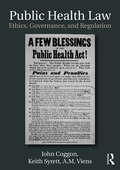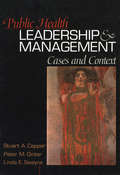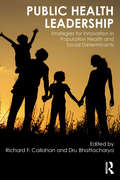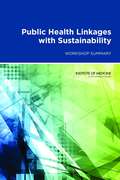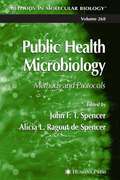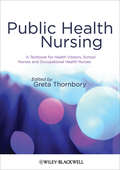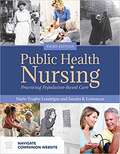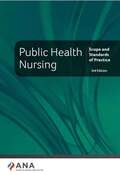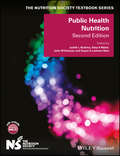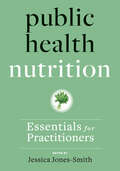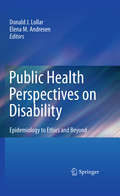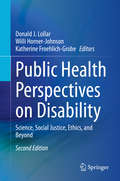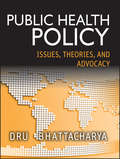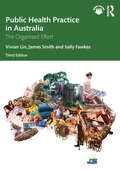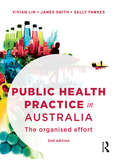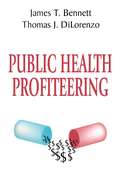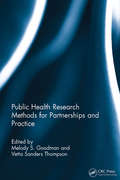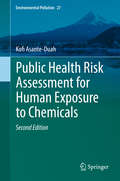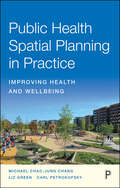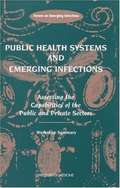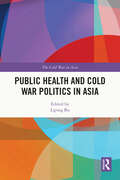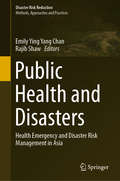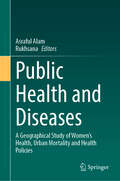- Table View
- List View
Public Health Law and Ethics: Power, Duty, Restraint
by Lawrence O. Gostin Lindsay F. WileyPublic Health Law and Ethics defines these fields for a new generation. This bold and updated edition probes how the Covid-19 pandemic has fundamentally changed the legal landscape for public health practice. Through incisive analysis of public health legislation, judicial opinions, and scholarly research, this accessible primer articulates the scope and limits of governmental powers and duties to protect the public's health, builds a case for why social justice must be prioritized as a core value of public health ethics, examines the role of the courts in striking down democratically enacted laws, and covers today’s most pressing health issues, such as chronic diseases, opioid overdoses, gun violence, disability rights, sexual and reproductive autonomy, and racial and gender equity. The book creates a framework for ensuring public health interventions are based on sound scientific evidence and consistent with ethical values, revealing complex answers to the essential question of what community members owe one another when it comes to health.
Public Health Law: Ethics, Governance, and Regulation
by John Coggon A. M. Viens Keith SyrettPublic health activity, and the state’s public health responsibilities to assure the conditions in which people can be healthy, can only be achieved through different means of social coordination. This places law and regulation at the heart of public health. They are fundamental both to methods of achieving public health goals and to constraints that may be put on public health activity. As such, trainees, practitioners, and leaders in public health need to understand the breadth and nature of wide-ranging legal and regulatory approaches and the place of ethics in public health. Public Health Law, written by three leading scholars in the field, defines and examines this crucial area of study and practice. It advances an agenda whose scope extends far beyond that covered in traditional medical law and health care law texts. The authors provide an account of the scale of contemporary public health policy and practice and explain its philosophical depths and implications and its long legislative and regulatory history. They advance a definition of the field and explore how different legal approaches may serve and advance or constrain and delimit public health agendas. This ground-breaking book presents the field of public health ethics and law and goes on to examine the impact within the UK of private law, criminal law, public law, EU and international law, and ‘softer’ regulatory approaches. It is a primary point of reference for scholars, practitioners, and leaders working in public health, particularly those with an interest in law, policy, and ethics.
Public Health Leadership and Management: Cases and Context
by Dr Stuart A. Capper Dr Peter M. Ginter Dr Linda E. SwayneThe six chapters and fifteen cases contained in this book challenge students to ask the appropriate questions and stimulate their thinking about public health leadership and management. The situations presented by each case are vivid and provide not only a basis for practicing professional public health judgements but also provide a lasting impression that aids in retention of the lessons learned.
Public Health Leadership: Strategies for Innovation in Population Health and Social Determinants
by Richard Callahan Dru BhattacharyaDesigned for professionals and aspiring professionals in public policy, public health, and related programs, Public Health Leadership illustrates the complexity of contemporary issues at the intersection of public health and healthcare and the compelling need to engage numerous public and private stakeholders to effectively advance population health. Offering real-world case studies and cutting-edge topics in public health and healthcare, this book will complement existing primers and introductory books in public health to help students and practitioners bridge concepts and practice. The work is divided into three parts that focus on the new role of public health departments, emerging challenges and opportunities following the enactment of the Patient Protection and Affordable Care Act (ACA), and recent trends in innovation and investment. Each chapter is practice-oriented to provide insight into the changing landscape of public health while offering practical tips based on the experiences and expertise of leading practitioners. Topics include cross-sector partnership-building, innovations in investment strategies, public health operations, performance management, advances in big data tracking, and more that address the social determinants of health and improve population health. Cases draw on a wide range of perspectives and regions, encouraging the reader, whether a professional or student, to apply the lessons learned to one’s local context.
Public Health Linkages with Sustainability
by Institute of Medicine Christine Coussens Board on Population Health and Public Health Practice Roundtable on Environmental Health Sciences, Research, and Medicine Erin RuschIn 1992 world leaders met at the Earth Summit in Rio de Janeiro to reaffirm the Declaration of the United Nations Conference on the Human Environment that was established on June 16, 1972 in Stockholm. The meeting resulted in the adoption of Agenda 21 by the member states which is a framework for the transition to a more sustainable world. In 2012 the members gathered to assess and reaffirm the importance of progress towards the efforts of Agenda 21. In response to this the Institute of Medicine's (IOM's) Roundtable on Environmental Health Sciences, Research, and Medicine held a workshop to inform the policies that are discussed at the 2012 Earth Summit. The workshop, held in Woods Hole, Massachusetts on July 25-26, 2011, focused on the issue of sustainability and health as well as the linkages that are currently present between the two. The workshop included presentations and discussions which are summarized in Public Health Linkages with Sustainability: Workshop Summary. The report presents how different areas of public health, such as food and water resources, link to sustainability and opportunities or venues that can be examined.
Public Health Microbiology
by John F. Spencer Alicia L. Ragout de SpencerA collection of readily reproducible laboratory methods for the determination of various pathogenic microorganisms, their effects, and possible measures that can be taken to counter them. For bacterial and viral pathogens, the authors give special attention to PCR methods for detecting genes resistant to tetracycline, for resistance in Salmonella enterica, and for identifying and typing Campylobacter coli. For fungi the authors offer methods for computerized analysis and typing of fungal isolates, for the isolation and enumeration of fungi in foods, and for the determination of aflatoxin and zearalenone. Other methods deal with hazard analysis, the use of disinfectants, microbiological analysis of cosmetics, microbiological tests for sanitation equipment in factories, and the uses of animals in studies of various characteristics of lactobacilli. Review articles address the spread of pathogens from livestock and poultry production, including the threat of prion-based diseases.
Public Health Nursing
by Greta ThornboryPublic Health Nursing is an essential resource for all health visiting students, school nursing students, and occupational health nursing students, that reflects the current key changes in community public health nursing. It is a key textbook for specialist practitioner programmes, and those new to the public health arena.Written by relevant experts in the field, this practical textbook uniquely explores the three main specialties of Public Health Nursing: Health Visiting, School Nursing and Occupational Health Nursing. A particular strength of the book is the way it shows the diversity of each discipline and how they each address Public Health in vastly different ways according to the needs of their relevant population.This will be essential reading for all students on the Specialist Community Public Health Nursing (SCPHN) programmes offered across the UK.Key features:Focuses on the specialist community public health nursing part of the NMC registerMultidisciplinary, with contributors from all three specialismsConcerned with improving the health of the population, rather than treating the diseases of individual patientsFocuses on practice and competencies
Public Health Nursing: Practicing Population-based Care
by Sandra B. Lewenson Marie Truglio-LondriganPublic Health Nursing: Practicing Population-Based Care, Third Edition is a comprehensive resource for students and faculty interested in public health nursing and education. The text takes a historical perspective in covering the challenges of public health nursing and offers evidence for why things are done the way they are. The authors accomplish this by providing a world view of various types of clinical experiences and by encouraging a conversation around how to invite the population to be active and engaged in the initiatives which promote public health. The Third Edition covers the role of nursing in primary health care, the history of public health nursing, the science of population-based care inclusive of epidemiology and social epidemiology, evidence-based practice for population health. In addition, coverage of technology for research, data storage, retrieval, trend identification, as well as technological innovations for educational program delivery to a population and social networking are also featured. Key Features: New chapter on the ethics of population-based care New chapter on the environment Minnesota Department of Health population-based intervention wheel Expanded content on disaster preparedness featuring case studies on Hurricane Katrina and the disaster in Haiti Additional information on the Patient Protection and Affordable Care Act
Public Health Nursing: Scope and Standards of Practice
by American Nurses AssociationThe Public Health Nursing: Scope and Standards of Practice, 3rd Edition, is an essential document for every public health nurse practicing in the United States. The scope of practice statement answers the who, what, when, where, how, and why questions of public health nursing. The standards provide authoritative statements of the actions and behaviors that all registered public health nurses are expected to competently perform, regardless of role, population, specialty, and setting. The product of extensive thought work by many registered nurses, this new edition provides 18 national standards of practice and professional performance. Each standard is accompanied by detailed competencies for the three practice levels. This premier professional resource informs and guides public health nurses in their vital work providing safe, quality, and competent care. It is a must-have for every registered public health nurse.
Public Health Nutrition (Second Edition)
by John M. Kearney Judith L. Buttriss Susan A. Lanham-New Ailsa A. WelchIn this second edition of the bestselling title from the acclaimed Nutrition Society Textbook series, Public Health Nutrition has been extensively revised to ensure that it reflects the latest evidence-based knowledge and research. Ground-breaking and comprehensive in both its scope and approach, Public Health Nutrition has been fully updated by an expert editorial team to cover the most recent changes in the field. It now offers a structured overview of the subject’s core concepts and considers public health nutrition tools and the application of intervention strategies. Divided into five key sections, Public Health Nutrition contains a wealth of information, including: Public health nutrition concepts and assessment tools, and their application in light of the latest evidence. Case studies to illustrate how best to apply the theory and evidence to policy and practice. An examination of nutrition throughout the lifecycle, and the relationship between diet and disease, including in relation to obesity, diabetes, cancer, as well as mental health. The impact of environmental factors on public health. Public health strategies, policies and approaches. With a clear and concise structure, Public Health Nutrition is an essential purchase for students of nutrition, dietetics and other healthcare areas, as well as an invaluable practical guide for health professionals working within public health. A supporting companion website featuring multiple-choice, short answer, and essay style questions is available at www.wiley.com/go/buttriss/publichealth
Public Health Nutrition: Essentials for Practitioners
by Jessica Jones-SmithNutrition is a fundamental building block for optimal health. In this essential textbook, Jessica Jones-Smith presents readers with a balanced introduction to the field of public health nutrition. Examining common nutrition-related problems in both high- and low-income countries, Jones-Smith allows students to draw connections between the principles and realities of public health nutrition. She also describes the fundamental tools of public health nutrition, from nutrition assessment to program monitoring and evaluation, as well as current and future solutions for public health nutrition's most pressing issues.Covering fundamental topics while helping students build the knowledge and skills foundational to public health nutrition research and practice, the book addresses • nutrition surveillance• dietary assessment methods• program planning and program evaluation• environmental and underlying determinants of nutrition-related diseases in high-, middle-, and low-income countries• monitoring and evaluation in nutrition programs• nutrition epidemiology• community health assessment• nutrition-related policies and programs, with a particular focus on WIC in the United States and cash transfer programs in low- and middle-income countries• leading causes of disease and death• obesity• stunting• nutrition transitionsThe text also provides a much-needed resource for established researchers and practitioners of public health nutrition. Each chapter is authored by preeminent experts in the field, and the book includes aids for classroom learning, including case studies, learning objectives, and review questions. A rigorous introduction to foundational knowledge, Public Health Nutrition concludes with a discussion of current and future solutions for pressing health issues.Contributors: Jeanne Barcelona, Alexandra L. Bellows, Sara Bleich, Melissa Chapnick, Damien de Walque, Rachael Dombrowski, Jess Fanzo, Lia C.H. Fernald, Susan E. Filomena, Johannah Frelier, Valerie M. Friesen, Melissa Hidrobo, Paul Gertler, Lora Iannotti, Scott Ickes, Lindsay M. Jaacks, Jessica Jones-Smith, A. Gita Krishnaswamy, Noel Kulik, Mduduzi N.N. Mbuya, Kimberly Morland, Lynnette M. Neufeld, Vanessa Oddo, Cynthia Ogden, Colin Rehm, Scott Richardson, Sarah Ross-Viles, Marie Ruel, Julie Ruel-Bergeron, Garrison Spencer, Marie Spiker, Andrew Thorne-Lyman, Alison Tumilowicz, Kelsey Vercammen, Marissa Zwald
Public Health Perspectives on Depressive Disorders
by Edited By Neal L. CohenHow does mental health impact public health?In 2001, the WHO recognized depressive disorders as the leading cause of disability worldwide. But most Americans who meet diagnostic criteria for major depression are untreated or undertreated. Luckily, recent advances have finally made it possible for the field of public health to address mental health in the population. Public Health Perspectives on Depressive Disorders fills a gap by identifying the tools and strategies of public health practice and by exploring their application to twenty-first-century public mental health policy and practice.By looking at depressive disorders through a public health lens, this book highlights the centrality of mental health to public health. Linking the available research on depressive illness at the population level with public mental health policy and practice, expert contributors set a research agenda that will help make mental health a central part of public health science and practice. This book is an invaluable resource for researchers and practitioners to develop, facilitate, and conduct pilot and feasibility studies of promising preventive and treatment interventions that might mitigate the progression toward major depression and other mental disorders among populations at risk.The first part of the book underscores the public health significance of depressive illness by focusing on the evidence provided by recent approaches to nosology, epidemiology, illness burden, and impact on overall health. The second part looks at the social and environmental influences on depressive disorders that are critical to future efforts to prevent illness and to promote mentally healthy communities. The third and longest part addresses the vulnerability of diverse groups to depressive illness and underscore best practices to mitigate risk while improving both the preventive and therapeutic armamentaria.
Public Health Perspectives on Disability
by Donald J. Lollar Elena M. AndresenTraditionally, the public health viewpoint on disability was geared toward primary prevention of disabling conditions or events. More recently, with the movement for disability rights and the emergence of disability studies, the challenge to the field has been to promote positive health outcomes in this underserved community. Such a change in public health culture must start at the educational level, yet training programs have generally been slow in integrating this perspective--with its potential for enriching the field--into their curricula. Public Health Perspectives on Disability meets this challenge with an educational framework for rethinking disability in public health study and practice, and for attaining the competencies that should accompany this knowledge. This reference balances history and epidemiology, scientific advances, advocacy and policy issues, real-world insights, and progressive recommendations, suiting it especially to disability-focused courses, or to add disability-related content to existing public health programs. Each chapter applies awareness and understanding of disabled persons' experience to one of the core curriculum areas, including: Health services administration, Environmental health science and occupational health, Health law and ethics, The school as physical setting, Maternal, child, and family health, Disasters and disability. In Public Health Perspectives on Disability, faculty, researchers, administrators, and students in graduate schools of public health throughout the U.S. will find a worthy classroom text and a robust source of welcome--and much needed--change.
Public Health Perspectives on Disability: Science, Social Justice, Ethics, and Beyond
by Donald J. Lollar Willi Horner-Johnson Katherine Froehlich-GrobeIn this new edition, the editors and contributors update and expand on the educational framework that was introduced in the first edition for rethinking disability in public health study and practice and for attaining the competencies that should accompany this knowledge. The second edition highlights key areas of research that have emerged since the first edition was published. This edition includes new and updated chapters that have particular relevance for public health practice: Disability, Intersectionality, and Inequity: Life in the MarginsDisability and Health Programs: Emerging PartnersChildren with Special Healthcare NeedsDisasters and Disability: Rhetoric and RealityInter-relationship of Health Insurance and Employment for People with DisabilitiesPublic Health, Work, and DisabilityActions to Prepare a Competent Workforce Public Health Perspectives on Disability: Science, Social Justice, Ethics, and Beyond, 2nd Edition, is an essential resource for public health educators and practitioners as well as students in graduate schools of public health throughout the United States.
Public Health Policy
by Dhrubajyoti BhattacharyaPublic Health Policy: Issues, Theories, and Advocacy offers students an engaging and innovative introduction to public health policy: its purpose, how it is originated, and how it is implemented. The book describes the underlying theories and frameworks as well as practical analytical tools needed for effective advocacy and communication. Drawing on the multidisciplinary nature of public health, the book uses concepts and examples from epidemiology, law, economics, political science, and ethics to examine the policymaking process, explain positions pro or con, and develop materials for various audiences to further a public health policy intervention. In addition, Public Health Policy shows how policymaking is a complex and integrated top-down and bottoms-up process that embraces a myriad of public and private stakeholders.Written by a highly experienced health policy researcher and teacher, the book is rich in resources that will enhance teaching and learning. Each chapter begins with an overview of the chapter, including core terms and concepts, and includes illustrative examples of how the highlighted component (law, ethics, economics, politics, epidemiology, and medicine) intersects with public health. Discussion questions at the end of every chapter, along with an interview from an expert from each of the component fields, give real-world perspectives on how that particular subject relates to the overall topic. The book also contains 13 case studies that illustrate the framework discussed in the first part of the book, and show how the different components link to create, sustain, evaluate, or obstruct the development of public health policy. Also included are primers on two essential policy tools: how to write research policy briefs, and how to craft effective letters to an editor, including examples of both drawn from the author's publications in journals and newspapers.
Public Health Practice in Australia: The Organised Effort
by James Smith Sally Fawkes Vivian LinThe third edition of Public Health Practice in Australia has been written as the impact and effects of the COVID-19 pandemic are starting to be fully understood.The book takes a systems approach to public health, examining the impact of historical, social, economic, environmental, and political factors on the health of individuals, communities, and populations. Linking theoretical issues to contemporary practice, it highlights common threads that underlie seemingly disparate activities, ideas, and entities that comprise the organised effort of public health practice. As well as the COVID-19 pandemic, and the health inequalities that it has highlighted, the new edition also emphasizes the importance of ecological health and the impact of climate change on public health.Timely and comprehensive, and including case studies throughout to bring key concepts to life, this is an invaluable resource for students and professionals across the health sciences, including public health, medicine, environmental health, health promotion, health information management, and health administration.
Public Health Practice in Australia: The organised effort
by James Smith Sally Fawkes Vivian LinPublic Health Practice in Australia offers a thorough introduction to what public health practitioners do, and the 'effort' involved in improving the health of the public.This second edition has been fully revised and updated in line with current policies and practice. It highlights common threads that underlie seemingly disparate activities, ideas and entities that comprise the organised effort of public health practice. The emphasis is on securing and maintaining the conditions in society that enable people to live healthy and fulfilling lives.The authors examine the impact of historical, social, economic, environmental and political factors on the health of individuals, communities and populations. Taking an applied, multidisciplinary approach, they outline the strategies and tools that public health practitioners use to improve health outcomes: identifying infrastructure needs in the workforce, public and private sector organisations, and in regulation; gathering, analysing and using health data; applying interventions in health policy, provision of health services and health promotion.Public Health Practice in Australia draws on current international and Australian research and the interwoven case studies make the theories and concepts come alive. It is a valuable resource for students and professionals across the health sciences including public health, medicine, environmental health, health promotion, health information management and health administration.'The book is impressive in the completeness, clarity and consistency of the material covered, and for the way in which many of the theoretical issues are related to current practice. An extremely useful and valuable reference for both students and practitioners alike.' - Thomas Tenkate, Environmental Health
Public Health Profiteering
by Thomas J. Dilorenzo James T. BennettThe diet industry feeds on the hopes and the fears of those who need-or think that they need-to lose weight. Since the publication of the first known diet book in 1864, a host of sanctimonious preachers and self-proclaimed experts-often overweight themselves-have stoked fears of obesity effectively for both profit and political power, none more so than former surgeon general C. Everett Koop. In Public Health Profiteering, James T. Bennett and Thomas J. DiLorenzo offer a scathing and irreverent assessment of Koop's public and private career showing how a brilliant pediatric surgeon has evolved into a self-seeking and hypocritical public scold.During his term as Surgeon General under the Bush administration, Koop, enamored of the military trappings of title and uniform, saw himself as leading an army of public health administrators against an enemy. As often as not, the enemy took on the disquieting countenance of the American people. In Koop's view they were stupid, improvident, feckless, unable to make the simplest decisions about their lives. As Bennett and DiLorenzo show, he used his position as a bully pulpit for intemperate attacks on the tobacco and alcohol industries and to irresponsibly exaggerate the dangers of obesity. While taking a prohibitionist line, Koop himself smoked a pipe, drank martinis, and weighed in at a hefty 210 pounds. Although Koop claimed that he would never cash in on his office, his subsequent career tells a far different story. He has lobbied, hawked, and endorsed products for a host of firms: Wyeth Ayerst (makers of the dubious diet drug Fen-Phen), Weight Watchers, Jenny Craig, Intel, Neurocrine, Kelloggs, BioPure, and many others.Lively in style and carefully researched, Public Health Profiteering will be of interest to health policy specialists, political scientists, economists, and media analysts.James T. Bennett is professor of economics at George Mason University. He is founder and editor of the Journal of Labor Research and has authored many books and articles, including Health Research Charities: Image and Reality and Official Lies: How Washington Misleads Us, co-authored with Thomas DiLorenzo.Thomas DiLorenzo is professor of economics at the Sellinger School of Business and Management at Loyola College in Baltimore. He has co-authored many books and is widely published in academic journals as well as the popular press, including the Wall Street Journal and USA Today.
Public Health Research Methods for Partnerships and Practice
by Melody S. Goodman Vetta Sanders ThompsonTranslating research into practice involves creating interventions that are relevant to improving the lives of a target population. Community engaged research has emerged as an evidence-based approach to better address the complex issues that affect the health of marginalized populations. Written by leading community-engaged researchers across disciplines, each chapter covers a different topic with comprehensive guides for start-to-finish planning and execution. The book provides a training curriculum that supports a common vision among stakeholders as well as a survey of methods based on core MPH curriculum. Practical appendices and homework samples can be found online. Public Health Research Methods for Partnerships and Practice will appeal to researchers and practitioners in community or government sectors interested in conducting community-engaged work.
Public Health Risk Assessment for Human Exposure to Chemicals
by Kofi Asante-DuahThis book provides a concise, yet comprehensive overview of the many facets relating to human health risk assessments in relation to chemical exposure problems. It presents some very important tools and methodologies that can be used to address chemical exposure and public health risk management problems in a consistent, efficient, and cost-effective manner. On the whole, the book represents a collection and synthesis of the principal elements of the risk assessment process that may be used to more effectively address issues pertaining to human exposures to chemicals found in modern societies. This also includes an elaboration of pertinent risk assessment concepts and techniques/methodologies for performing human health risk assessments. Written for both the novice and the experienced, the subject matter of this book is an attempt at offering a simplified and systematic presentation of public health risk assessment methods and application tools - all these facilitated by a layout that will carefully navigate the user through the major processes involved. A number of illustrative example problems are interspersed throughout the book, in order to help present the book in an easy-to-follow, pragmatic manner.
Public Health Spatial Planning in Practice: Improving Health and Wellbeing
by Michael Chang Liz Green Carl PetrokofskyHealth and wellbeing are significantly influenced by how professionals plan, design and manage the environment. This book supports those working in the built environment and public health sectors, with the knowledge and insight to maximise health improvement through planning and land use decisions. Supported by examples of policy and approaches, it focuses on implementation and delivery, and sets out what is needed to achieve healthier environments within the parameters of legislative and policy frameworks. It demonstrates how when we harness the art and science of public health spatial planning, can we begin to effect changes to the policies and decisions that shape population health.
Public Health Systems and Emerging Infections: Workshop Summary
by Joshua Lederberg Johnathan R. DavisThe Forum on Emerging Infections was created in 1996 in response to a request from the Centers for Disease Control and Prevention and the National Institutes of Health. The goal of the forum is to provide structured opportunities for representatives from academia, industry, professional and interest groups, and government to examine and discuss scientific and policy issues that relate to research, prevention, detection, and management of emerging infectious diseases. A critical part of this mission has been the convening of a series of workshops. Public Health Systems and Emerging Infections summarizes the fourth in a series of five workshops.With a focus on our knowledge and understanding of the role of private and public health sectors in emerging infectious disease surveillance and response, the participants explored the effects of privatization of public health laboratories and the modernization of public health care. The issues discussed included epidemiological investigation, surveillance, communication, coordination, resource allocations, and economic support.
Public Health and Cold War Politics in Asia (The Cold War in Asia)
by Liping BuBu and her contributors illustrate the complexity of tensions and negotiations in the development of different types of public health systems in Asia during the early Cold War. Competing models of development with different political ideologies and economic enterprises increasingly influenced Asian countries in their efforts to build modern nations after World War II. Looking at examples from China, Japan, South and North Korea, India, and Indonesia, the contributors to this volume look at how a range of Asian countries handled this postcolonial challenge. Health became a pivotal area that sustained the political discourse of differentiating one type of society from the other and promoting each system’s advantages over the other’s during the Cold War. Central to the discourse of a just society and the well-being of citizens was the promotion of public health and welfare for the people. The right to health was considered a fundamental human right as well as an essential social justice. A healthy population was also a prerequisite for national economic prosperity. Public health in postwar Asia was, therefore, a sociopolitical matter as well as a concern for the well-being of individuals. The health of the people demonstrated the advancement of a nation and provided the insurance for economic productivity and national prosperity. An essential read for historians and policymakers of public health and historians of Asia during the Cold War.
Public Health and Disasters: Health Emergency and Disaster Risk Management in Asia (Disaster Risk Reduction)
by Rajib Shaw Emily Ying Yang ChanThis book presents the health emergency and disaster risk management (H-EDRM) research landscape, with examples from Asia. In recent years, the intersection of health and disaster risk reduction (DRR) has emerged as an important interdisciplinary field. In several landmark UN agreements adopted in 2015–2016, including the Sendai Framework for Disaster Risk Reduction 2015–2030, the 2030 Sustainable Development Goals (SDGs), the Paris climate agreement, and the New Urban Agenda (Habitat III), health is acknowledged as an inevitable outcome and a natural goal of disaster risk reduction, and the cross-over of the two fields is essential for the successful implementation of the Sendai Framework. H-EDRM has emerged as an umbrella field that encompasses emergency and disaster medicine, DRR, humanitarian response, community health resilience, and health system resilience. However, this fragmented, nascent field has yet to be developed into a coherent discipline. Key challenges include redundant research, lack of a strategic research agenda, limited development of multisectoral and interdisciplinary approaches, deficiencies in the science–policy–practice nexus, absence of standardized terminology, and insufficient coordination among stakeholders. This book provides a timely and invaluable resource for undergraduate and postgraduate students, researchers, scholars, and frontline practitioners as well as policymakers from across the component domains of H-EDRM.
Public Health and Diseases: A Geographical Study of Women's Health, Urban Mortality and Health Policies
by Rukhsana Asraful AlamThis book provides a multi-disciplinary exploration of gender, public health, and disease with a focus on urban areas impacted by climate change. In three sections, global case studies are provided that analyze health risk management strategies in vulnerable populations containing high rates of mortality and disease morbidity. The sections are broadly divided along the themes, of women's health and gendered health challenges, demographic health issues such as aging populations, and the impacts of urbanization on health and the strategies to improve public health in urban areas such as green space projects. The book will be useful resource for students and researchers of health geography and public health, as well as public health practitioners and policymakers.

